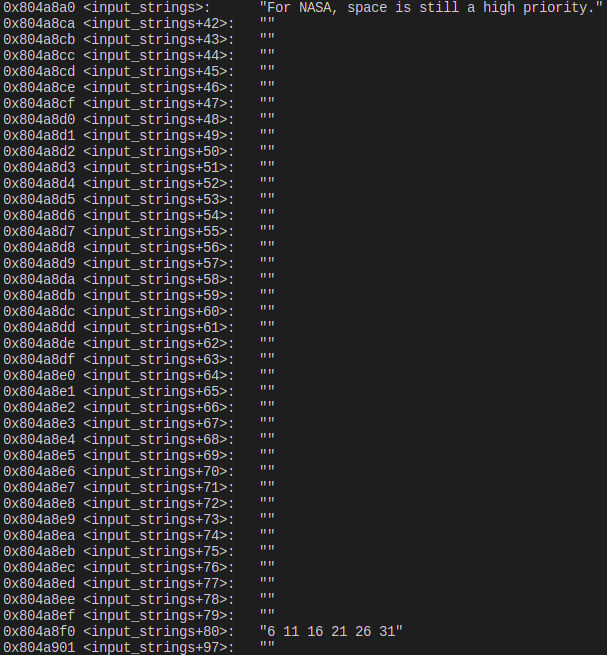更新于:2024-04-09T23:17:58+08:00
深入理解计算机系统——二进制炸弹实验
实验简介
二进制炸弹是一个作为目标代码文件的程序。运行时,它提示用户输入若干个不同的字符串。如果其中一个不正确,炸弹就会“爆炸”,打印出一条错误信息。用户必须通过对程序的反汇编和逆向工程来求出这六个字符串,解决这些炸弹。该实验的主要目的是,深入理解汇编语言,并学习使用 gdb 调试器。
在本次实验中,我们需要拆解七个炸弹(其中一个为隐藏炸弹)。
实验预备
下载完实验材料后,有两个文件值得关注:bomb 和 bomb.c 。bomb 就是要“拆解”的目标文件代码,而 bomb.c 只是辅助理解的部分源代码文件。首先,对 bomb 进行逆向:
1 objdump -d bomb >> bomb.s
得到反汇编文件 bomb.s ,然后,在该文件中找到相关函数的反汇编代码,开始拆解炸弹!
拆弹
phase_1
1 2 3 4 5 6 7 8 9 10 11 12 13 14 phase_1:
比较字符串,若相等就不会爆炸。找到目标字符串。
gdb找到:
成功!
phase_2
再来看第二个炸弹的反汇编代码。
1 2 3 4 5 6 7 8 9 10 11 12 13 14 15 16 17 18 19 20 21 22 23 24 25 26 phase_2:
仔细阅读后发现,程序先调用了 read_six_numbers 的函数,而在之前,程序准备了一个参数放在 %esp+4 处,该参数的意义需要进一步阅读下面的代码才能知晓。之后,程序就进入了一个循环,用于不断测试条件,如果条件不符,炸弹就会爆炸!显然,该循环就是关键,这个炸弹就是考验汇编语言的循环部分了。经整理,循环用 C 代码表示如下:
1 2 3 4 5 6 7 *a = &(ebp-0x1c );for (int i = 1 ; i <= 5 ; i++) {-1 ]+5 ;if (eax != edx)
现在,明白 read_six_numbers 函数的参数 ebp-0x1c 是一个数组地址。大致可以猜到,只要输入 6 个数字,相邻两个差为 5 即可拆解炸弹。
等等,并不是任意的差为 5 的等差数列都满足要求!对首项,read_six_numbers 函数也有要求:
1 2 3 4 5 6 7 8 9 10 read_six_numbers:
看起来,输入的首项必须比 5 大,那么首项就是 6 吧 :smile:。
验证一下:
phase_3
再接再厉,开始拆解第三个炸弹。phase_3 函数的汇编代码明显长了不少,先看第一部分:
1 2 3 4 5 6 7 8 9 10 11 12 13 14 15 16 17 18 19 20 21 phase_3:
注意到,程序调用了函数 sscanf 。该函数的意义是,从第一个参数的字符串中读取变量的值。就本次调用而言,函数共准备了四个参数,分别位于%esp %esp+0x4 、 %esp+0x8 和 %esp+0xc 。其中,%esp 就是我们输入的行字符串,这 0x8049972 表示的是:
看来是需要输入两个整数。那么,最后的两个参数就一定是输入的整数了,%esp+0x8 是第一个整数地址,%esp+0xc 应该是第二个整数地址。sscanf 函数完成后,读入的两个整数就位于 ebp-0xc 和 ebp-0x10 中。
然后对这两个整数做简单判断:要求第一个整数要大于 1 且小于等于 7,否则炸弹会爆炸。接下来,看函数的第二部分:
1 2 3 4 5 6 7 8 9 10 11 12 13 14 15 16 17 18 19 20 21 22 23 ;...
第二句汇编又出现了一个奇怪的数字 0x8049978 ,在gdb 调试程序中,打开一看,就会发现其中的奥秘:
在0x8049978 处,存放了后面 8 条语句的地址!显然,这就是一个跳转表,PC 接下来该指向哪里,完全取决于 %edx ,也即输入的第一个数字的值。如果第一个数为 2 ,那么程序最终计算 %ebp-0x8 处的值就是 0xff91 (当然不是计算得到的,通过gdb调试器得出的结果)。于是输入的数值可以为 2 和 -111。
经验证,第三颗炸弹已被拆除,感兴趣的话,也可以尝试一下其他数值。不过注意到,程序最后规定,第一个数字不能大于 5 !
phase_4
第四颗炸弹:前面和第三颗炸弹一样,调用了 sscanf 函数。那么这次,sscanf 函数使用了什么字符串呢?看起来只要输入一个整数就行:
1 2 3 4 5 6 7 8 9 10 11 12 13 14 15 16 17 18 19 20 21 22 23 24 25 26 phase_4:
经gdb调试后,%ebp-0xc 是输入的整数,必须大于 0 ,而 sscanf 函数的返回值必须为 1,否则炸弹会引爆。然后,程序就开始调用 func4 函数了。注意到,func4 函数的返回值必须等于 0x37 否则炸弹会爆炸。那么 func4 函数是怎么计算的呢?
1 2 3 4 5 6 7 8 9 10 11 12 13 14 15 16 17 18 19 20 21 22 23 24 25 func4:
仔细阅读后,整理成如下 C 代码:看起来就是一个斐波那契数列 :joy:。结合 func4 函数的返回值必须是 0x37 ,那么很容易想到,问题是让我们求出,斐波那契数列的哪一项是 0x37 。
1 2 3 4 5 6 7 8 9 int func4 (int n) {if (n > 1 ) {-1 )+func4(n-2 );return sum;else {0x1 return eax;
嗯,第 9 项,输入 9 就可以拆除炸弹了。
phase_5
与炸弹四一样,phase_5 阶段一开始也调用了 sscanf 函数,用 gdb 调试,找到要求输入的字符串:需要给出两个整数。
1 2 3 4 5 6 7 8 9 10 11 12 phase_5:
当输入了两个整数后(已经很熟悉了, %esp+0x8 和 %esp+0xc 指向了两个输入整数的地址,而%ebp-x14 和 %ebp-0x18 存放了整数值),接下来看看炸弹怎么对这两个整数进行操作。
1 2 3 4 5 6 7 8 9 10 11 12 13 14 15 16 17 18 19 20 21 22 23 24 25 mov -0x14(%ebp),%eax
仔细阅读汇编代码,初步得出结论:输入的第一个整数会作为一个数组的索引,在一个循环中不断累加,得到的累加值会与输入的第二个整数比较。炸弹不爆炸的条件是:循环次数必须为 11 次(0x1-0xb),且第二个整数的值与累加值相等。
首先,来看一下位于 0x804a5c0 的数组吧:
由于要求循环次数必须为 11 次,而终止循环的条件是 %eax == 0xf ,也就是说取到数组中的 0xf 才能结束循环,那我们从后往前推,要取到 0xf ,必须取到 0x6 (因为 0xf 的索引是 6),取到 0x6 ,必须先取到 0xe ……
于是有:0xf -> 0x6 -> 0xe -> 0x2 -> 0x1 -> 0xa -> 0x0 -> 0x8 -> 0x4 -> 0x9 -> 0xd -> 0xb。累加起来值为(不算0xb)82。于是,输入 11 和 82 就可以拆解炸弹。
phase_6
最后一个炸弹,继续前进。注意到,phase_6 先调用了 atoi 函数,看来是要把某个字符串变为整数。
1 2 3 4 5 6 7 8 phase_6:
首先,还是要用 gdb 调试器看看 0x804a66c 和传入的参数 %ebp+0x8 是什么东西。
得出的信息有点少(主要是看不懂这个字符串),而且 0x804a66c 处的字符串为空。随后,程序很快就调用了 fun6 函数:
1 2 3 4 5 6 7 call <atoi@plt>
fun6 函数完成后,会进入一个循环,从下面的汇编代码可以看到,循环中不断重复的一条有效指令就是 (%ebp-0x4)=((%ebp-0x4)+0x8) 。从这点上看,可以理解为 (%ebp-0x4) 是一个指针,而这种循环更像是对链表的遍历。后来,根据我的不断尝试,发现该炸弹确实是对一个链表进行操作。
1 2 3 4 5 6 7 8 9 10 11 12 13 14 15 16 17 18 19 mov %eax,-0x8(%ebp)
fun6 函数非常复杂,但仔细观察发现,该函数运行后产生的结果与我们给的输入无关。那么就有一个技巧,可以用gdb调试器在 fun6 函数返回后设置断点,观察其返回值 %eax==0x804a618 。然后,上述汇编代码的循环会执行 5 次,我使用 gdb 调试器将整个链表的值都打印在下图中。0x804a618 对应的是 node7,而上面汇编代码中,要求 %edx==[0x804a66c] ,其对应的是 node0,经过多次实验,我发现,node0 为用户输入的值(见下图,输入 5 时)。
那么问题来了,应该输入什么才能拆解炸弹呢?顺着程序过一遍,一开始 %eax=0x804a618,指向了 node7,然后根据 (%ebp-0x4)=((%ebp-0x4)+0x8) ,链接到下一个节点,一共执行 5 次,先后是 node3、node5、node9、node8 ,遍历后, %ebp-0x4中的值应该为 0x804a60c(见下图),当从中取出的值也为 0x20e 时,才能拆解炸弹。
如下图,已经成功拆解完 6 个炸弹。
secret_phase
一切还没结束,从汇编代码看,我们还剩一个隐藏炸弹没有拆解掉。首先,我们需要找到隐藏炸弹的输入入口。否则,gdb 调试器是帮不了我们的。全局搜索一下,发现在 phase_defused 函数下找到了 call secret_phase 语句。
经分析,确认是要在拆解完所有炸弹后,才有机会见到这枚隐藏炸弹。而如何输入密语也是非常考验我们的水平的!因此,先要细细研究 phase_defused 函数:
1 2 3 4 5 6 7 8 9 10 11 12 13 14 15 16 17 18 19 20 21 22 23 24 phase_defused:
重点是 sscanf 函数及其参数,第一个参数是 %edx ,指向 0x804a990 ,第二个参数是 0x8049e38,其实是一个字符串(见下图), 第三个参数和第四个参数分别是 %ebp-0x58 和 %ebp-0x54 。从后半部分代码看出,要求输入的字符串必须是 austinpowers,且 sscanf 函数返回值为 2,意思是整数和字符串必须都有对应的输入。
再来看看 0x804a990 (见下图),很奇怪的是,它只有一个 “9”,这样的话,sscanf 函数的返回值就只能是 1 了,我们就没法打开隐藏关卡了。还有,这个 <input_string> 是什么?
看起来,要先解决 <input_string> 的问题,不过,一切来的很轻松(见下图)。看来,我们之前拆炸弹的每一个输入都以 80 字节对齐的方式存放于此!这样看来,就是要在第 4 个炸弹拆解时,后面加上字符串 austinpowers, 就可以发现隐藏炸弹了!
终于,我们来到了隐藏炸弹,现在看看这一炸弹的具体代码。
1 2 3 4 5 6 7 8 9 secret_phase:
看起来,需要读入一行,并且读入的这一行会使用 atoi 函数转为数字。要求数字必须为正数,且小于 0x3e9 。
1 2 3 4 5 6 7 8 9 10 11 12 13 14 15 16 17 18 19 mov %eax,-0x8(%ebp)
重点是 fun7 函数,其参数有两个,一个是我们输入的数字,另一个是立即数 0x804a720,这个立即数不应当是一个“数字”,更有可能是一个指针。由上面的代码可知,返回值应该为3,否则就会爆炸。接下来,仔细研究一下 fun7 的代码。
1 2 3 4 5 6 7 8 9 10 11 12 13 14 15 16 17 18 19 20 21 22 23 24 25 26 27 28 29 30 31 32 33 34 35 36 37 38 39 fun7:
转化为 C 代码,可能比较方便理解,可见,还是递归函数。
1 2 3 4 5 6 7 8 9 10 11 12 13 14 15 16 17 18 19 20 int fun7 (int *a, int b) {if (*a & 0x0ffff == 0 ) {return -1 ;else {if (*a <= b) {if (*a != b) {8 byte;int ret = fun7(a, b);return ret;else return 0 ;else {4 byte;int ret = fun7(a, b);return ret;
现在,需要让 fun7 函数返回值为3,应当如何设置a 和 b 的值呢?不难想到,返回值为3,要求最内部的函数返回值为0,然后再返回1,再返回3,但首先,需要知道 0x804a720的值。经过多次尝试,求出如下数据:
根据之前的推算,需要调用三层 fun7 函数,第一次需走入 *a<b 的分支,第二次也是,第三次需要走入 *a==b 的分支,这样返回的值才能为3。倒推回去,第一次指针为 0x804a720 ,第二次需要 +8,指针地址为 0x804a708 ,然后再加8,为 0x804a6d8 ,此时指针指向的值是 0x6b 。要求输入的值与 0x6b 相等,才能返回3,因此,拆解该炸弹的答案是 107。
最后的最后,解答成功!
总结
回头看这几颗炸弹的拆解过程,每颗炸弹难度递增,考点不一但都极具代表性。第一阶段考察了字符串比较,需要我们熟练使用 gdb 调试器。第二阶段考察了汇编语言的循环部分,能否理解循环非常关键。第三阶段考察了汇编语言的 switch 语句的实现。第四阶段考察了递归函数调用,第五阶段考察了数组索引以及循环结构,第六阶段则是关于链表的遍历。最后的秘密阶段更是融合了多个考点,做完之后很有成就感!




















